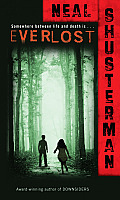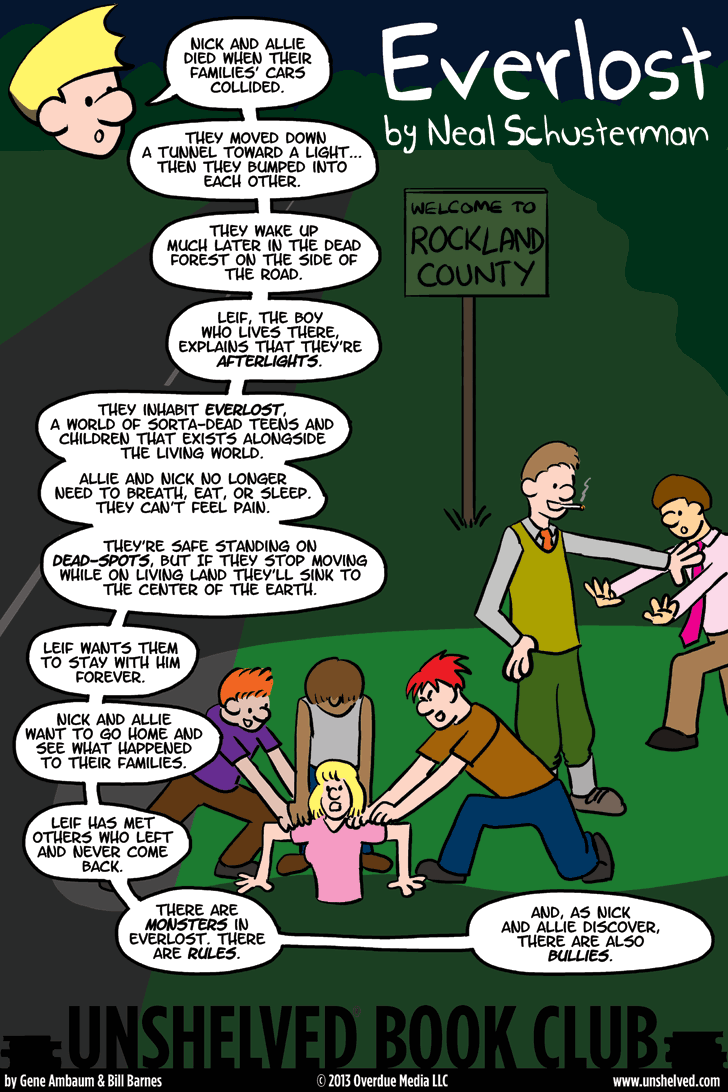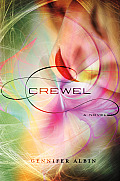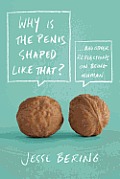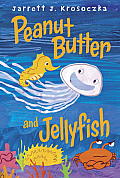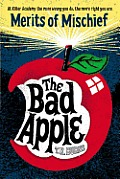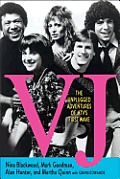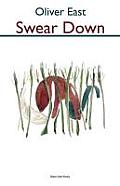Link to this review in the form of a comic strip by geneambaum tagged paranormal
Link to this review by rose tagged fantasy • coming of age
Arras is a magical world “woven” on top of a war torn earth, where the Coventry’s Spinsters weave all aspects of human life into existence.
Adelice’s parents have been telling her for years that she must hide her gift for weaving, so that she isn’t forced to work as a Spinster. Officials discover her skill, however, and come to take her away. After being dragged around to show the public their newest Spinster, she’s tossed into a cell. Then she’s primped and plucked and brought into Spinster society in the Coventry. She will live there, in a mansion, eat lavish food, and be eternally beautiful. But she can never leave. It is an elegant prison.
Why I picked it up: The cover. It’s really pretty and whimsical, with colorful swirls and a face viewed from above.
Why I finished it: Adelice soon learns that she will be the next Creweler, one of a few powerful Spinsters with more power over the weave than others. But soon after her training begins, her mentor kills herself. The charismatic politician, Cormac, offers her a deal: marry him, or be brainwashed and then forced to marry him anyway. Adelice is horrified by it all and plans her escape.
I’d give it to: My friend, Olivia. She loves arts and crafts, especially things with fabric, thread and yarn, so she would be really fascinated with what the Spinsters do. Also, she loves stories with problematic romances in them, and this has a great love triangle.
Link to this review by sharonlevin tagged nonfiction • science
This book explores physiology, evolution, and psychology to try to explain why people look, feel, and behave certain ways. In one chapter Bering delves into such subjects like women who like men who like men, in which he tries to figure out the benefits and the downsides for straight women who have a lot of gay male friends. Is it true that being a “fairy princess” (a less negative-sounding term than “fag hag”) means that a woman’s self-image is negative? (No.) In another he explains exactly why the human penis is shaped the way it is (as the cover promises) — the “cap” on top evolved its shape to remove other semen that’s already in the vagina, increasing a man’s chances of reproduction (while reducing that for previous sex partners).
Why I picked it up: I couldn’t resist a cover where the title and subtitle are featured in word balloons as a conversation between two walnuts.
Why I finished it: With chapters like “Not So Fast…What’s So “Premature” About Premature Ejaculation?” this is a fun book to open randomly.
Bering’s book grabbed me from the introduction where he describes an incident in sixth grade. He told an eleven-year-old girl that his penis was more a scimitar than a dagger, and that it didn’t seem as if it was be the correct shape to penetrate a vagina. He learned this type of behavior is inappropriate in most company except in scientific circles, where questioning anything is okay.
I’d give it to: My lovely spousal unit, Ismayil, because he would attempt to tell his coworkers about what he learned in it and discover it’s impossible to do so without making many inappropriate hand gestures.
Link to this review by geneambaum tagged picture book
Peanut Butter (a seahorse) and Jellyfish are best friends. They love swimming around together. Unfortunately they have to put up with Crabby, who makes fun of them as they swim past.
Why I picked it up: Krosoczka writes the funny Lunch Lady books.
Why I finished it: Crabby’s insults are excellent, from “You guys swim like humans!” to ”I’ve seen sea snails swim with more style.”
I’d give it to: Shannon, who recently moved to Newburyport, MA. I know that she won’t be able to refuse adding this book to her collection because of the colorful, wide-eyed undersea creatures. But I also want to hear if she gets any guff because of the scenes where Crabby freaks out at being caught in a lobster trap.
Link to this review by craigseasholes tagged picture book
Quotations from Martin Luther King, Jr., Gandhi, Jimi Hendrix, Jimmy Carter, Emma Goldman, Whoopi Goldberg, Mark Twain, and many, many others stitch together pencil and watercolor illustrations of everyday acts of kindness, and support Halperin’s proposed antidote to war and the suffering it causes.
Why I picked it up: After watching the Boston Marathon, I turned to children’s picture books for solace and inspiration. I recognized her amazing art from Turn! Turn! Turn!, and I loved the Mother Teresa quote on the back cover: “Peace begins with a smile.”
Why I finished it: Every page deserves attention and discussion. On the first Halperin asserts, “For there to be peace in nations, there must be peace in cities.” It’s followed by drawings of scenes from around the world. A boy seated on the subway appears to be considering if he will give up his seat to a man with a cane. A girl looks past her own red lunch box to consider the lady with rumpled clothing and a shopping cart who shares her park bench. A barefoot boy beside a street-side fruit stall notices loaded bags falling from a cyclo-cart. Will he tell the driver? Would you? Running between all three images runs a quote, “It’s not so much the journey that’s important, as is the way we treat those we encounter and those around us, along the way.”
The book moves from nations to cities to neighborhoods to schools to homes and to the center pages, where colorful drawings by school children illustrate Halperin’s central message, “For there to be peace in homes, there must be peace in our hearts.” (The book then moves outward to show how that will bring peace to the world.)
I’d give it to: Sarah, a hardworking teacher who will particularly appreciate the words of former Peace Corps director Carol Bellamy, “In serving the best interests of children, we will serve the best interests of all humanity.” I think Sarah will leave Peace for her students to discover and ponder.
Link to this review by gigi tagged humor • coming of age
Seamus accidentally killed a substitute teacher by throwing an apple at her. Seamus is sent to a reform school, the Kilter Academy. At first he’s terrified that he will be killed. The head of the school threatens him one moment, but then acts normal the next. He slowly realizes that the Kilter Academy isn’t a reform school, it’s a school that encourages mischief and teaches kids how to behave badly. To succeed in each class he must pull a trick on each of his teachers, which is hard because each of them is an expert at a different type of mischief.
Why I picked it up: On the cover it says, “ At Kilter Academy the more wrong you do, the more right you are.”
Why I finished it: I wanted to see if Seamus and his friends pranked Mr. Tempest, a very serious teacher who doesn’t like anybody. It’s extra credit because he’s really hard to prank.
I’d give it to: Marcus, because he’d like Houdini, the teacher who is always stealing stuff from the students. Everyone tries to hide their stuff from him — stuffed animals, sunglasses, and the like. To pass his class, students have to steal something from him without him knowing.
Link to this review by flemtastic tagged biography • history
When MTV started in 1981, it wasn’t an instant hit. The channel was not available on all cable networks, and even the producers weren’t sure it would fly. But it caught the zeitgeist by capturing and fueling society’s obsession with music videos and rocketing the five video jockeys to national fame. They were truly flying by the seat of their pants: writing their own copy, figuring out where to stand to segue between videos, and navigating interviews with sassy rock stars. They were each hired because they were diverse in age, sex and race, and also in terms of musical knowledge. J.J. Jackson was a friend of Led Zeppelin and a legend in the industry for his work in radio hosting and music reporting while Martha Quinn was a fresh-faced kid straight out of college. Nina Blackwood was the rocker, Mark Goodman the nice Jewish dude, and Alan Hunter the All-American. Together they shaped the initial years of MTV. This loose collection of their anecdotes features many 80s stars like the J. Geils Band, Cyndi Lauper, and Madonna.
Why I picked it up: I was one of the American kids who watched the first video play on MTV. (It was The Buggles’ “Video Killed the Radio Star.”)
Why I finished it: There were numerous stories about VJ’s interviewing musicians that they idolized. When Martha Quinn spoke to Paul McCartney, she was a card-carrying member of the Beatles’ fan club. Alan Hunter and Mark Goodman share stories of doing cocaine and crystal meth with various rock stars backstage at concerts and on set between interview segments, while Nina Blackwood, considered the hot rocker chick, had to fend off several rockers who wanted to sleep with her. There were fights, bruised egos, and communication problems, but in general, the tiny, cramped studio and single dressing room required all five VJ’s to function as a family.
I’d give it to: Bradley, who was a teen in the 90s but correctly considers the 80s to be a better musical decade. These anecdotes will make him even more insufferable about 80’s musical trivia than he already is.
Link to this review by flemtastic tagged nonfiction • biography
At the age of thirteen, Samantha Geimer went to Jack Nicholson’s house to pose for pictures for movie director Roman Polanski, who had stated he wanted to do a fashion shoot for the French version of Vogue magazine. What happened next is not subject to guesswork. Both Geimer and Polanski have admitted that they had sex. Polanski even testified that he knew she was thirteen. Fearing the publicity of a trial, and wanting to keep Samantha out of the public eye, the family agreed to a plea deal for Polanski in which he served six months in prison and submitted to a psychiatric review. When the judge negated the deal and sentenced Polanski to an indeterminate amount of jail time, Polanski bought the last seat on a plane to Heathrow and spent the next thirty plus years in a villa in France.
This is is Samantha’s account of the intense, continued interest in the case every time Polanski’s name resurfaces in the media due to a movie premier and, recently, his arrest in Switzerland and possible extradition to the U.S.
Why I picked it up: I knew the barest minimum about the case of Roman Polanski and the crime that has kept him out of the U.S. for thirty-five years, and which even cost him the chance to pick up his Oscar in person. I figured that the first extensive comments from the victim herself would be a good place to learn more.
Why I finished it: I expected it to be about an outraged family demanding justice for a criminal on the run, but it didn’t read like that. Instead, Geimer’s family has spent much of the previous two decades arguing for Polanski’s release from exile. This has led to people labeling Geimer an apologist for Polanski; many think she suffers from Stockholm Syndrome. However, she lays out the reasons why she supports Polanski clearly and concisely, showing that while she abhors what he did, the punishment does not fit the crime. In fact, she saves her vitriol for the judicial system and the media, claiming that their goals were never to serve justice or to protect her, but to tell lurid tales about Samantha, and bring attention to Judge Laurence J. Rittenband, who seems more motivated by public sentiment than justice.
I’d give it to: Camillo, who knows Polanski only through his films. Many people supported Polanski during his rape trial, claiming that his artistic temperament got him in trouble. They blamed Geimer’s mother or claimed Samantha was a “young hooker.” He would probably enjoy getting a fuller picture of Polanski as a human being, not just a director whose story has played out in the press.
Link to this review by geneambaum tagged biography • graphic novel • nonfiction
Oliver East is supposed to be writing about his son’s difficult, premature birth in a family scrapbook. He takes his sketchbooks and begins walking in a straight line out his door, on a path that would eventually take him from England to Brittany, Spain, Morocco, and on.
Why I picked it up: I’m a huge fan of East’s Trains Are…Mint and Proper Go Well High.
Why I finished it: East walks along the path, sketching and drawing the scenery. He illustrates and comments on what he sees, but his thoughts always turn back to his wife, his son and the birth. The way he can’t quite focus on his family is brilliant because it allows him to slowly reveal how his wife nearly died after giving birth, and it shows how freaked out he is to concentrate on that. And I loved how, when he later walks the line with his wife and son, I got to see him as a father and a husband.
I’d give it to: Michele and Beck. It’s the perfect postpartum gift for them, since they just had twins three days ago. They’ll think of me when they can’t quite make out East’s handwriting (mine is even less legible), and I hope they’ll love East’s personal, nearly impressionistic drawings as much as I do.
